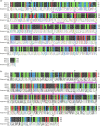Subgenome-specific assembly of vitamin E biosynthesis genes and expression patterns during seed development provide insight into the evolution of oat genome
- PMID: 27135276
- PMCID: PMC5096403
- DOI: 10.1111/pbi.12571
Subgenome-specific assembly of vitamin E biosynthesis genes and expression patterns during seed development provide insight into the evolution of oat genome
Abstract
Vitamin E is essential for humans and thus must be a component of a healthy diet. Among the cereal grains, hexaploid oats (Avena sativa L.) have high vitamin E content. To date, no gene sequences in the vitamin E biosynthesis pathway have been reported for oats. Using deep sequencing and orthology-guided assembly, coding sequences of genes for each step in vitamin E synthesis in oats were reconstructed, including resolution of the sequences of homeologs. Three homeologs, presumably representing each of the three oat subgenomes, were identified for the main steps of the pathway. Partial sequences, likely representing pseudogenes, were recovered in some instances as well. Pairwise comparisons among homeologs revealed that two of the three putative subgenome-specific homeologs are almost identical for each gene. Synonymous substitution rates indicate the time of divergence of the two more similar subgenomes from the distinct one at 7.9-8.7 MYA, and a divergence between the similar subgenomes from a common ancestor 1.1 MYA. A new proposed evolutionary model for hexaploid oat formation is discussed. Homeolog-specific gene expression was quantified during oat seed development and compared with vitamin E accumulation. Homeolog expression largely appears to be similar for most of genes; however, for some genes, homoeolog-specific transcriptional bias was observed. The expression of HPPD, as well as certain homoeologs of VTE2 and VTE4, is highly correlated with seed vitamin E accumulation. Our findings expand our understanding of oat genome evolution and will assist efforts to modify vitamin E content and composition in oats.
Keywords: homeolog expression; oat evolution; oat homeologs; seed composition; tocols; vitamin E.
Published 2016. This article is a U.S. Government work and is in the public domain in the USA. Plant Biotechnology Journal published by Society for Experimental Biology and The Association of Applied Biologists and John Wiley & Sons Ltd.
Conflict of interest statement
The authors declare that they have no conflict of interests.
Figures




References
-
- Abrouk, M. , Murat, F. , Pont, C. , Messing, J. , Jackson, S. , Faraut, T. , Tannier, E. et al. (2010) Palaeogenomics of plants: synteny‐based modelling of extinct ancestors. Trends Plant Sci. 15, 479–487. - PubMed
-
- Badaeva, E.D. , Yu Shelukhina, O. , Goryunova, S.V. , Loskutov, I.G. and Pukhalskiy, V.A. (2010) Phylogenetic relationships of tetraploid AB‐genome Avena species evaluated by means of cytogenetic (C‐banding and FISH) and RAPD analyses. J. Bot. 2010: 1–13. doi:10.1155/2010/742307. - DOI
MeSH terms
Substances
LinkOut - more resources
Full Text Sources
Other Literature Sources
Medical

